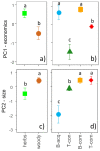Using Plant Functional Traits to Define the Biomass Energy Potential of Invasive Alien Plant Species
- PMID: 37765361
- PMCID: PMC10535227
- DOI: 10.3390/plants12183198
Using Plant Functional Traits to Define the Biomass Energy Potential of Invasive Alien Plant Species
Abstract
The eradication of invasive alien plant species (IAPS) is mandatory worldwide, but the resulting biomass is still considered waste. The energy use of biomasses obtained from IAPS eradication may represent ecological and economic benefits, creating synergies with restoration projects. We evaluated whether the growth forms and functional types identified using the functional space of 63 IAPS corresponded to a possible bioenergy use through multivariate analysis techniques. We extracted leaf and nutrient traits and Grime's CSR plant strategies from an existing database. We calculated the carbon-to-nitrogen ratio (C:N) and gross heating value (GHV) as indicators of biochemical or thermal processes, respectively. For 10 species, we measured the above-ground biomass C:N and GHV (including leaves, stems and branches) and correlated them with those of leaves and with plant adaptive strategies. We identified four groups of IAPS indicative of the main trade-offs between plant economics and size variation, which respectively correlated with C:N and GHV. Herbaceous IAPS were better suited to biochemical processes, and woody IAPS to thermal ones. Overall, Grime's CSR strategies were the best tool to define the IAPS bioenergy potential. In the long term, competitive and ruderal IAPSs can represent a reusable feedstock until their complete eradication.
Keywords: Grime’s CSR plant strategies; bioeconomy; biofuels; eradication; global change; global spectrum of plant form and function; plant functional traits; restoration ecology.
Conflict of interest statement
The authors declare no conflict of interest.
Figures







References
-
- Richardson D.M., Pysek P., Rejmánek M., Barbour M.G., Panetta F.D., West C.J. Naturalization and invasion of alien plants: Concepts and definitions. Divers. Distrib. 2000;6:93–107. doi: 10.1046/j.1472-4642.2000.00083.x. - DOI
-
- Pyšek P., Richardson D.M., Rejmánek M., Webster G.L., Williamson M., Kirschner J. Alien plants in checklists and floras: Towards better communication between taxonomists and ecologists. Taxon. 2004;53:131–143. doi: 10.2307/4135498. - DOI
-
- Dalle Fratte M., Bolpagni R., Brusa G., Caccianiga M., Pierce S., Zanzottera M., Cerabolini B.E.L. Alien plant species invade by occupying similar functional spaces to native species. Flora. 2019;257:151419. doi: 10.1016/j.flora.2019.151419. - DOI
Grants and funding
LinkOut - more resources
Full Text Sources

